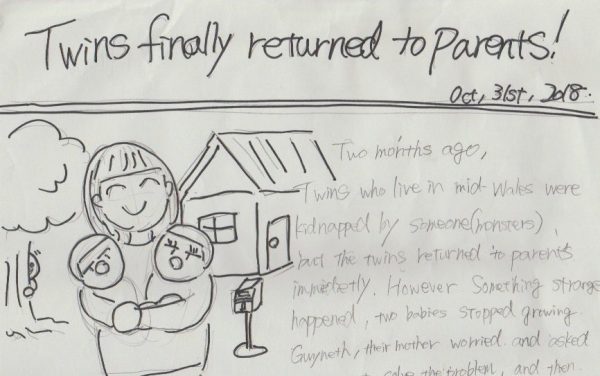
Storytelling in ELT is often seen as the preserve of the young learner teacher. Telling a story with lots of repetition, noises, and action is considered far too childish for teen and adult learners. But stories are in our soul, we grew up with them, remember them fondly and can learn a lot from them, so maybe stories can be part of language lessons for older students.
Why storytelling?
The benefits of grading reading are well documented. Students reading for pleasure at their own level not only improve their reading skill but also their grammar and vocabulary level. But why is so little said about Graded Listening. When we do a listening activity in an English lesson there is always a task to go with it. This listen and answer approach often stresses students, no wonder then that listening is often considered by students to be the ‘hardest’ skill to master. We rarely ask students to just listen for pleasure. We rarely say don’t worry about it; there won’t be a ‘test’ at the end. But could that be beneficial for students? Could it help them to improve their listening skills and their grammar and vocabulary like grading reading does?
Case Study
I’ve been telling stories with students for about three years but at the end of 2018, I spent three months teaching young adults in Japan and decided to do a little experiment. At least once a week I told them a story. Sometimes I did nothing with it, just told it at the beginning or the end of the lesson and moved on. Sometimes we briefly discussed the story and then moved on. Sometimes I built a lesson around the story. I told the story using actions, pictures and sounds if needed to help with the meaning but still in an adult way. The students enjoyed the stories, and they produced some really excellent work based on them. When I asked them at the end of the course if they could remember the stories, they listed them and took pleasure in retelling them to each other.
Here is some of the feedback that I’ve been receiving from students:
- ‘Thanks to the storytelling lessons, I got skills for listening, imagination and retelling.’
- ‘This definitely helped our listening skills…. we could communicate with each other and try to express our thoughts, ideas, and so on.’
- ‘Those stories let me imagine the view, place, person and a lot of other stuff.’
- ‘I learnt many expressions, including what I’ve never used to express myself.’
- ‘It’s motivating to listen eagerly.’
- Some activities gave me a power of understanding.’
One student even asked me if I could help her to become a storyteller like me!
Activities
The first activity I did after each story was simply to ask students to retell the story to each other. This helped them fill the gaps in each other’s knowledge, developed their understanding of the story, and gave them a chance to ask me questions. Because I had a few artistic students in my class, I encouraged them to draw the story at this stage. Here are three other activities that I will look at in my Webinar.
Newspapers
Ask the students to make a newspaper article for their story. Show them a narrative newspaper story, ask about the features, how the story is told in the newspaper, who is being interviewed etc. Then ask the students to work in small groups to create a newspaper front page based on the story.

Prequel or Sequel?
Ask them to write a prequel or sequel to the story. Talk about films like Star Wars or Harry Potter. How did the story move on? Then, ask the students to think about the story and how the characters would develop in 5, 10, or 15 years’ time. Put them in small groups and ask them to write their new versions of the story.

Get them to write a twitter feed for each of the characters. This is a bit more complicated to set up, but it worked like a charm. First you need to break the story down into factual components. Then, ask them to think how each character would respond to the event and how they would update their twitter feed. Ask them to write the Tweets and then put them in order to create a Twitter version of the story.

The last lesson
In my last lesson with the students, I asked them to tell me a story from Japan. I put the students into groups and gave them time to plan and then asked them to tell me the story. Their renditions were fun, enthusiastic and brought a tear to my eye.
I genuinely believe that listening for pleasure has a place in language learning and storytelling can give students a chance to listen to something that is enjoyable and understandable, and this takes the pressure off listening.
Gareth Davies is a writer, storyteller, teacher, and teacher trainer based in Cardiff. He has been in the ELT industry for 23 years teaching in Portugal, the UK, Spain, and the Czech Republic. Recently he has been teaching and storytelling in Japan. Since 2005, Gareth has worked closely with Oxford University Press, delivering teacher training and developing materials. Gareth is also an examiner for the new Oxford Test of English and Trinity College, London. Outside of teaching, Gareth is an author of fiction, a poet and a storyteller. His first novel “Humans, Being”, will be published by Cinnamon Press in April 2019. He is interested in developing creative writing and story-telling ideas for the classroom.
Visit Gareth’s website: www.gareththestoryteller.com


[…] via Developing listening skills with storytelling | Gareth Davies — Oxford University Press […]
[…] Developing listening skills with storytelling is from Oxford University Press. I’m adding it to The Best Listening Sites For English Language Learners. […]
Thank you. It’s lovely to get the students involved in the e four macro- skills.
[…] they are reaching out and connecting with new methods of learning and applied from of teaching. Stories can link not only between the child’s world of classroom and home environment but also between the Indian school classroom and […]
[…] It is an applied form of teaching is a new method of learning that your child must be exposed to. Stories can link not only between the child’s world of classroom and home environment, while it is important to make your child, expressive, intelligent, creative […]
[…] they are reaching out and connecting with new methods of learning and applied from of teaching. Stories can link not only between the child’s world of classroom and home environment but also between the Indian school classroom and […]